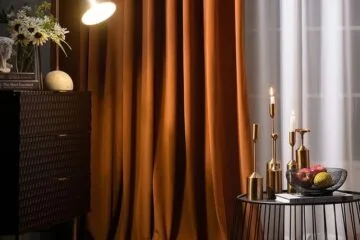What is Chenille Fabric
Chenille fabric is a plush, soft textile known for its distinctive fuzzy surface, created by placing short lengths of yarn between two core yarns and then twisting the yarn together. The name “chenille” comes from the French word for caterpillar, which the yarn resembles due to its fuzzy texture. This fabric can be made from a variety of fibres including cotton, rayon, acrylic, and olefin, contributing to its versatility. Chenille’s construction method gives it a unique and luxurious appearance, making it a popular choice for home décor items like upholstery, curtains, and throw pillows, as well as in fashion for garments such as sweaters and scarves.
One of the notable characteristics of chenille fabric is its shimmering quality, which is a result of the way the fibres catch the light at different angles. This attribute, combined with its softness, makes chenille a favoured material for creating cozy and inviting atmospheres in interior spaces. However, chenille fabric can be delicate and may require careful handling and maintenance to preserve its texture and appearance. Chenille fabric is typically recommended to avoid high heat and excessive friction, which can flatten the pile and diminish its characteristic softness. Despite these care requirements, chenille remains a beloved fabric for its aesthetic appeal and tactile comfort.
What Is Chenille Fabric Made Of?
Furthermore, chenille fabric has a unique fuzzy texture, which is achieved through the unique weaving pattern of wrapping the short-length yarn (called piles) between a pair of core yarns. Since it’s made by tying the threads together, it’s stronger and more durable than many other fabrics.
How Is Chenille Fabric Used?
Chenille Fabric is primarily used for making upholstery, although you will also find garments, accessories like towels, and even bedding made from it.
For example, chenille rugs are extremely popular among homeowners, as the fabric renders a “soft to touch” texture with adequate depth. Hence, it makes for a luxurious cover for your floor. And by opting for a heavy weave variant, you can ensure that the rug stays put even with regular movement on top.
You can also use a chenille fabric to design cushions, sofas, chairs, couches, pillows, and even curtains or window coverings. The best part is chenille fabric is available in a range of colours and patterns to suit different interior setups for creating the look you desire.
Here are some options you can check out if you’re considering chenille fabric upholstery for your home or office.
Blue – French Chenille
If you want to go for a single colour fabric, a rich blue shade may well fit the bill. Closely resembling the look and feel of velvet, it has a light sheen that’s ideal for adding a pop of colour to any room. Or, you can also pair it with neutral or tropical colour schemes to create the perfect contrast.

2. Soho Heather – Chenille
Featuring warm, neutral tones of beige and purple, the Soho heather chenille has a distinct check pattern to create a simple yet rustic look. The raised weave pattern offers a smooth touch with just the right depth for a comfortable user experience.

3. Snowflakes – Chenille
The snowflakes chenille edition has multiple warm, single colours, like blue, red, green, grey, and black. Whether you use it for cushions in the bedroom or as upholstery for the living room sofa, the thick weave and snowflake pattern will bring a fresh look to the room.
Here, we’d recommend pairing this fabric with single-coloured walls or existing upholstery for a more sophisticated interior.

How To Care For Your Chenille Upholstery?
You can use a vacuum cleaner with a soft brush attachment on the lowest setting to gently clean the loose dirt and debris for regular maintenance.
In case of spills, put a towel immediately on it to soak the liquid. Do not rub vigorously, as it will damage the fabric. You can then use a hairbrush to slowly take out any solid material that may be stuck in the thread loops.
Follow it up with spot cleaning using a fabric cleaner and slowly dab it with a towel to remove any marks.
Summing Up: Chenille Fabric
That’s it for today!
We know that you’ll be raring to get your hands on some chenille fabric now, but remember that it may not be suitable for pets. Their sharp claws can easily dig into the loops of the fabric and rip it out, causing irreparable damage.
We’d also suggest buying the fabric from a reputed store, like us. Our high-quality chenille fabric is sourced from international mills that cater to some of the elitist designer labels of the world. You can speak to our expert team for any assistance!




